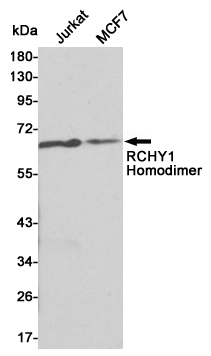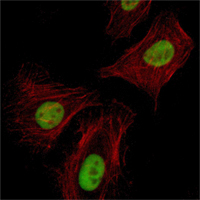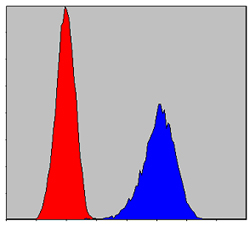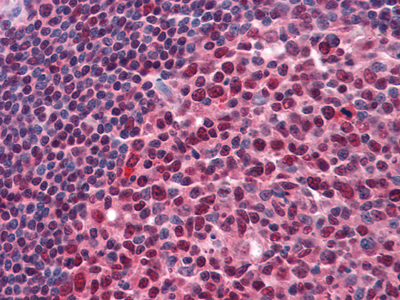Pirh21 (7B9) Mouse mAb
- 产品详情
- 实验流程
- 背景知识
Application
| WB, IHC-P, IF, FC, ICC |
|---|---|
| Primary Accession | Q96PM5 |
| Reactivity | Rat, Human |
| Host | Mouse |
| Clonality | Monoclonal Antibody |
| Isotype | IgG1 |
| Conjugate | Unconjugated |
| Immunogen | Purified recombinant fragment of human Pirh2 expressed in E. Coli. |
| Purification | Ascitic Fluid |
| Calculated MW | 30110 Da |
| Gene ID | 25898 |
|---|---|
| Other Names | ARNIP; CHIMP; RNF199; RCHY1 |
| Dilution | WB~~1:1000 IHC-P~~N/A IF~~1:50~200 FC~~1:10~50 ICC~~N/A |
| Format | Liquid in Purified antibody in PBS with 0.05% sodium azide. |
| Storage | Store at 4°C short term. Aliquot and store at -20°C long term. Avoid freeze/thaw cycles. |
| Name | RCHY1 |
|---|---|
| Function | E3 ubiquitin-protein ligase that mediates ubiquitination of target proteins, including p53/TP53, TP73, HDAC1 and CDKN1B (PubMed:16914734, PubMed:17721809, PubMed:18006823, PubMed:19043414, PubMed:19483087, PubMed:21994467). Mediates ubiquitination and degradation of p53/TP53; preferentially acts on tetrameric p53/TP53 (PubMed:19043414, PubMed:19483087). Catalyzes monoubiquitinates the translesion DNA polymerase POLH (PubMed:21791603). Involved in the ribosome-associated quality control (RQC) pathway, which mediates the extraction of incompletely synthesized nascent chains from stalled ribosomes: RCHY1 acts downstream of NEMF and recognizes CAT tails associated with stalled nascent chains, leading to their ubiquitination and degradation (PubMed:33909987). |
| Cellular Location | Nucleus. Nucleus speckle. Cytoplasm |
For Research Use Only. Not For Use In Diagnostic Procedures.
Provided below are standard protocols that you may find useful for product applications.
BACKGROUND
Swiss-Prot Acc.Q96PM5.Pirh 2 (P53 induced RING-H2 protein), also known as RCHY1, it forms dimers through its N- and C-terminus in cells. The Pirh2 has ubiquitin-protein ligase activity and it binds with p53 and promotes the ubiquitin-mediated proteosomal degradation of p53. The Pirh2 is oncogenic because loss of p53 function contributes directly to malignant tumor development. Pirh2 expression decreases the level of p53, and a decrease of endogenous Pirh2 expression increases p53 levels. Pirh2 is therefore considered, together with MDM2, to act as a negative regulator of p53 function.
终于等到您。ABCEPTA(百远生物)抗体产品。
点击下方“我要评价 ”按钮提交您的反馈信息,您的反馈和评价是我们最宝贵的财富之一,
我们将在1-3个工作日内处理您的反馈信息。
如有疑问,联系:0512-88856768 tech-china@abcepta.com.























 癌症的基本特征包括细胞增殖、血管生成、迁移、凋亡逃避机制和细胞永生等。找到癌症发生过程中这些通路的关键标记物和对应的抗体用于检测至关重要。
癌症的基本特征包括细胞增殖、血管生成、迁移、凋亡逃避机制和细胞永生等。找到癌症发生过程中这些通路的关键标记物和对应的抗体用于检测至关重要。 为您推荐一个泛素化位点预测神器——泛素化分析工具,可以为您的蛋白的泛素化位点作出预测和评分。
为您推荐一个泛素化位点预测神器——泛素化分析工具,可以为您的蛋白的泛素化位点作出预测和评分。 细胞自噬受体图形绘图工具为你的蛋白的细胞受体结合位点作出预测和评分,识别结合到自噬通路中的蛋白是非常重要的,便于让我们理解自噬在正常生理、病理过程中的作用,如发育、细胞分化、神经退化性疾病、压力条件下、感染和癌症。
细胞自噬受体图形绘图工具为你的蛋白的细胞受体结合位点作出预测和评分,识别结合到自噬通路中的蛋白是非常重要的,便于让我们理解自噬在正常生理、病理过程中的作用,如发育、细胞分化、神经退化性疾病、压力条件下、感染和癌症。









